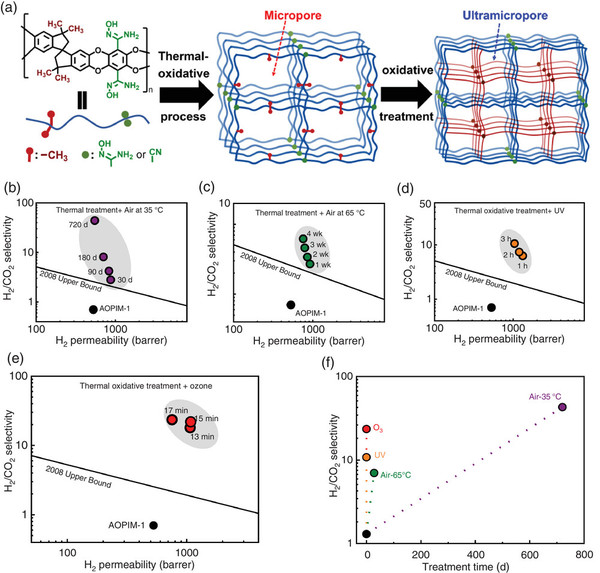Progressive Pore-Narrowing in Ultramicroporous Polymeric Membranes for High-Throughput H2/CO2 Separation
Lele Guo1, Zhenggong Wang1,2(王正宫)*, Yu Jiao1, Yu Zhang1, Michael D Guiver3*, Jian Jin1,2(靳健)*
1State Key Laboratory of Bioinspired Interfacial Materials Science &College of Chemistry, Chemical Engineering and Materials Science Soochow University Suzhou 215123, China
2Jiangsu Key Laboratory of Advanced Functional Polymer Materials &Jiangsu Key Laboratory of Advanced Negative Carbon Technologies Soochow University Suzhou 215123, China
3State Key Laboratory of Engines School of Mechanical Engineering Tianjin University Tianjin 30072, China
Adv. Funct. Mater.2025, 35, 2500706
Abstract: Efficient H2/CO2 separation using membrane technology is crucial for energy-efficient hydrogen production. However, due to the similar transport rates of the two gases, existing polymeric membranes face significant challenges in H2/CO2 separation. In this work, the microporous structure of polymer membranes is designed by a two-step collaborative cross-linking strategy to achieve ultra-permeable mixed-gas H2/CO2 separation, where rigid molecular cross-linking sites are incorporated into the polymer chains to stabilize the pore structure and the flexible molecular cross-linking sites are subsequently incorporated to finely tune the pore size of the membranes. Through this two-step collaborative cross-linking-based structure reconstruction (TSC-SR) strategy, a membrane derived from an amidoxime-functionalized polymer precursor achieves a H2 permeability of 1117.4 barrer and a H2/CO2 selectivity of 34.1, and a membrane derived from a nitrile-functionalized polymer precursor achieves a H2 permeability of 237.0 barrer and a H2/CO2 selectivity of 107.3. The performance of the two membranes is superior to all reported polymer membranes and even surpasses most inorganic membranes. The work not only demonstrates that polymeric membranes can effectively separate H2/CO2 but also represents a significant advancement in the design of polymeric membranes for gas separation.

Article information: https://doi.org/10.1002/adfm.202500706